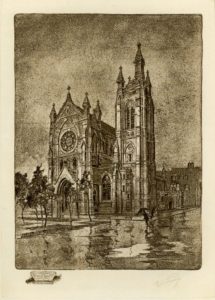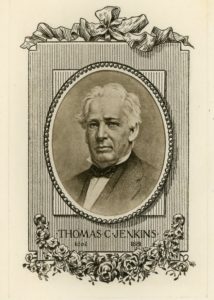
By Kristine Smets
Corpus Christi Church, at the corner of Mount Royal Avenue and West Lafayette Avenue, was built in memory of Thomas Courtney Jenkins, who would be celebrating his 215th birthday on March 19.
Jenkins was born in 1802, on the feast day of St. Joseph, the first son of William Jenkins (1767-1843), a successful businessman in Baltimore, and Ellen Willcox (1780-1816), of Delaware County, Pennsylvania.
After attending St. Mary’s College in Emmitsburg, some 50 miles northwest of Baltimore, he returned to the city and joined his father in the leather business. He was given an interest in the firm, but left six years later to establish the Poland and Jenkins firm with partner Poland Adams.
Jenkins became a prominent businessman and financier. He was one of the original organizers of the Parkersburg and Central Ohio Railroad, the Northern Central Railway, and the Atlantic Coast Line, and also organized the Merchants and Miners Transportation Company.
In 1829, he married Louisa Carrell from Philadelphia, the youngest daughter of John Carrell (1758-1830) and Mary Judith Moore (1766-1817). Her brother, George Aloysius Carrell (1803-1868), later became the first bishop of Covington, Kentucky, and Louisa probably met her future husband in Emmittsburg through George, who was also a student at St. Mary’s College. Louisa attended Mother Seton’s School in the same town.
The couple resided for many years at 608 North Calvert Street, in what was then called Waterloo Row. The family later moved to 721 St. Paul Street. Thomas and Louisa had 10 children, three of whom died in childhood; a son died during the Civil War.
Thomas and Louisa Jenkins were prominent figures in Baltimore’s Catholic community. Thomas was one of the first pew holders and oldest member of the Board of Trustees of the Baltimore Cathedral. They were engaged in many of the church’s charitable organizations. Thomas was an intimate friend of James Gibbons, Archbishop of Baltimore and later cardinal. They frequently hosted many of the prelates of the church at their home, especially during their attendance at the councils held in Baltimore.

Thomas Jenkins passed away on Christmas Eve in 1881. His wife died a year later, but not before she had asked her five remaining adult children—George, Eliza, John, Ellen and Michael— to build a church in memory of their father. Eventually, they erected the church in honor of both their mother and father.
It so happened that as the Jenkins children sought to build a church for their parents, Archbishop Spalding was hoping to establish a new parish, Corpus Christi, in the Bolton Depot area. He had already built a combination church/school in the area—a common practice at the time—and the congregation met in an improvised chapel on the top floor of the school until a permanent church could be erected.
Until that time, the Jenkins family had worshipped at the downtown cathedral, and had no official ties to the Bolton Depot area. Nevertheless, they were easily persuaded by the Archdiocese to construct their memorial church here. At the time, Mount Royal Avenue was one of the most beautiful and important boulevards of the rapidly expanding city. Perhaps they were also inspired by Isabella Brown, who had donated $150,000 ten years earlier to construct Brown Memorial Presbyterian Church in memory of her husband George Brown (son of Alex Brown, founder of the first investment banking firm in the U.S.), in the new, trendy neighborhood of Bolton Hill.
Ground was broken on March 17, 1885, and thirteen months later, the cornerstone of the new church was laid at the corner of Oliver Street (now Mount Royal Avenue) and Townsend Street (now Lafayette Avenue). On December 12, 1890, the remains of Thomas Courtenay Jenkins and his wife Louisa Carrell, were transferred to the crypt in the St. Joseph Chapel in the church. Corpus Christi was consecrated on January 1, 1891.
Further reading: Sources for this article include Requiescat in pace: A History of Corpus Christi-Jenkins Memorial Church (1973) by Frances Meginnis and Thomas Jenkins of Maryland, 1670: His Descendants and Allied Families, compiled by Edward Felix Jenkins (1985).
Kristine’s company Chainlines, which specializes in genealogical and historical research, is a Bulletin sponsor. Find out more about her services in this related article in this issue.
